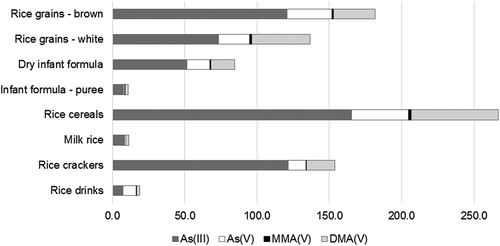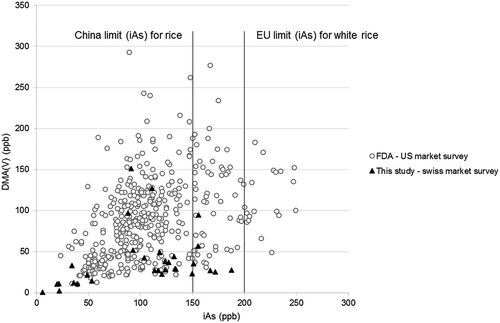Figures & data
Figure 1. IC-ICP-MS chromatogram of arsenic species of certified rice flour NIST 1568b. As(III): Arsenite, MMA(V) monomethylarsonic acid, DMA(V): dimethylarsinic acid, As(V): arsenate.

Table 1. Concentration of total arsenic and arsenic species, expressed as µg As kg−1 on total mass product, for each group of rice-based products.
Table 2. Median and range of iAs concentration (µg kg−1) in rice-based products (baby foods, dry form and ready-to-use form, rice cereals and rice crackers) destined for young children, from various study (US FDA, Citation2013; EFSA (European Food Safety Authority) Citation2014; Signes-Pastor et al. Citation2016b) and from the present study.
Table 3. Estimated dietary exposure to iAs for toddlers (all consumers)a.
Table 4. Estimated dietary exposure to iAs for toddlers (only consumers)a.
Table 5. Estimated exposure to iAs for toddlers via drinking water consumption.
Table 6. Estimated dietary exposure to DMA(V) for toddlers (all consumers).
Table 7. Estimated dietary exposure to DMA(V) for toddlers (only consumers).
Figure 2. The arsenic species profile (As(III), As(V), MMA(V), DMA(V)) among rice and rice-based products: rice grains – brown: 120.6, 31.1, 1.1, 28.7; rice grains – white: 73.5, 21.4, 1.4, 40.4; dry infant formula: 51.3, 16.2, 0.7, 16.1; infant formula – purée: 7.6, 1.0, 0.3, 2.0; rice cereals: 165.4, 39.3, 2.0, 60.3; milk rice:8.4, 0.6, 0.3, 1.9; rice crackers: 121.5, 12.4, 0.6, 19.2 and rice drinks: 7.1, 9.2, 0.3, 2.0. Concentrations are given in µg kg−1.

Figure 3. Concentrations of DMA(V) in relationship with iAs concentrations in rice grains from the FDA US market survey and from the current study (Swiss market survey). Concentrations are given in µg kg−1 or ppb. An amount of 150 µg kg−1 is the limit for iAs in rice set by China, the EU limit is 200 µg kg−1.

